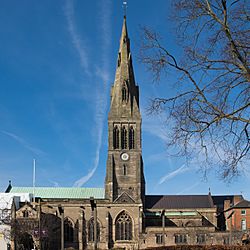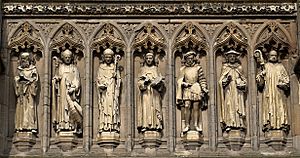Leicester Cathedral facts for kids
Quick facts for kids Leicester Cathedral |
|
|---|---|
| Cathedral Church of Saint Martin | |

Leicester Cathedral from the south
|
|
| Lua error in Module:Location_map at line 420: attempt to index field 'wikibase' (a nil value). | |
| Location | Leicester, Leicestershire |
| Country | England |
| Denomination | Church of England |
| Previous denomination | Roman Catholic |
| Architecture | |
| Designated | 5 Jan 1950 |
| Style | Gothic |
| Years built | 1086–1867 |
| Specifications | |
| Number of spires | 1 |
| Spire height | 67.1 metres (220 ft) |
| Bells | 13 |
| Administration | |
| Diocese | Leicester (since 1927) |
| Province | Canterbury |
The Cathedral Church of Saint Martin, Leicester, usually called Leicester Cathedral, is a Church of England cathedral in Leicester, England. It is the main church for the Bishop of Leicester. St Martin's is one of five medieval churches still standing in the city centre. It became a special church (a collegiate church) in 1922 and then a cathedral in 1927. This happened after a new Diocese of Leicester was created in 1926.
The remains of King Richard III were reburied in the cathedral in 2015. His bones were found nearby in the foundations of the old Greyfriars chapel. This discovery happened 530 years after he died in battle.
Contents
History of Leicester Cathedral
The church was built where Roman ruins once stood. It is named after St Martin of Tours, a Roman officer from the 4th century who later became a bishop. This church was likely one of six churches mentioned in the Domesday Book (1086). Parts of the building you see today date back to a 12th-century Norman church. This church was rebuilt in the 13th and 15th centuries.
In the Middle Ages, St Martin's was next to Leicester's Guild Hall. This made it the city's main church, with strong connections to local merchants and guilds.
Victorian Changes and New Status
Most of the building you see now was rebuilt in the Victorian era. This included the tower, finished in 1862, and the 220-foot spire, finished in 1867. These were designed by architect Raphael Brandon. The tower and spire are very impressive.
In 1927, St Martin's became Leicester's Cathedral. This was more than 1,000 years after the last Anglo-Saxon Bishop of Leicester had to leave because of invading Danes.
King Richard III's Final Resting Place
Today, over 100,000 people visit Leicester Cathedral each year. Many come to see the tomb of King Richard III. He was the last English king to die in battle. King Richard's remains were reburied in March 2015 by Justin Welby, the Archbishop of Canterbury. This followed five days of special events in Leicester.
His magnificent tomb is made from a single piece of Swaledale fossil stone. It weighs 3 tonnes and covers his grave. Inside the cathedral, you can see a special cloth called a pall. This decorative cloth covered King Richard's coffin during his reburial. It was designed by Jacquie Binns. The embroidery on it tells the story of King Richard's life. It also shows how his body was found in a car park very close to the cathedral.
Other interesting things inside the cathedral include 14th-century wooden figures. Each figure shows someone with a medieval illness. One has a hearing aid, and another has sore shoulders.
Recent Discoveries and Renovations
In 2022, archaeologists from the University of Leicester began digging at the cathedral. This is the same team that found King Richard III's remains. They discovered a burial ground from the late Anglo-Saxon period. This was part of a project to build a new heritage and education centre.
In March 2023, an 1,800-year-old Roman era stone altar was found in the cathedral grounds. This was also discovered by the University of Leicester team.
The tower and spire were cleaned and repaired in 2004–2005. This work cost about £600,000.
Cathedral Architecture
Leicester Cathedral is a listed building with a Grade II* status. This means it is a very important historic building. It has a large main area (nave) and a special area for the choir (chancel). There are also two smaller chapels next to the chancel. The 220-foot-tall spire was added in 1862.
The building has been restored many times over the centuries. Much of what you see today was designed by the Victorian architect Raphael Brandon. The cathedral looks mostly Gothic in style. Inside, a large wooden screen separates the nave from the chancel. This screen was designed by Charles Nicholson. In 2015, it was moved closer to King Richard III's tomb.
The Vaughan Porch
The Vaughan Porch is on the south side of the church. It was designed by J. L. Pearson, who also designed Truro Cathedral. The porch is named after the Vaughan family. Many members of this family served as vicars (church leaders) for a long time in the 1800s.
The front of the porch has seven statues of saints in stone niches. These figures are:
- Guthlac (c. 673–713): A Christian saint from Lincolnshire. He lived when Leicester first became a diocese (church area) in 680.
- Hugh of Lincoln (c. 1135–1200): A French monk who helped rebuild Lincoln Cathedral after an earthquake. Leicester was part of the Diocese of Lincoln in Norman times.
- Robert Grosseteste (c. 1175–1253): An English statesman, philosopher, and Bishop of Lincoln. He was also a famous Archdeacon of Leicester.
- John Wycliffe (c. 1329–1384): An Oxford scholar. He encouraged his followers to translate the Bible into English.
- Henry Hastings (c. 1535–1595): The 3rd Earl of Huntingdon. His family home in Leicester hosted Mary, Queen of Scots as a prisoner.
- William Chillingworth (1602–1644): An Oxford theologian. He was a chaplain in the Royalist army during the Civil War.
- William Connor Magee (1821–1891): Bishop of Peterborough. He helped build many Victorian churches and schools in Leicester. He later became Archbishop of York.
Chapels for Prayer and Remembrance
The cathedral has four chapels. Three are named after different saints.
- St Katharine's Chapel is on the north side. It is sometimes called the "Herrick Chapel." The window above the altar shows St Katharine, who was tortured on a wheel.
- St Dunstan's Chapel is on the other side of the chancel. It is a quiet place for prayer. A candle burns there to show that the sacrament (holy bread and wine) is kept for those too ill to come to church. The walls have memorials to people who prayed there.
- St George's Chapel was for the Guild of St George. It used to hold a statue of St George on a horse. This statue was carried through the streets every April 23rd. The chapel has memorials to soldiers from Leicestershire who died in past wars.
- Chapel of Christ the King was created at the east end of the cathedral. This was part of the changes made for the burial of Richard III.
Cathedral Services
Leicester Cathedral follows the traditions of the Church of England. It uses the Common Worship book for its main Sunday service, called the Choral Eucharist.
The Cathedral Choir
The Leicester Cathedral Choir includes the Boys Choir, Girls Choir, and Cathedral Songmen. Boys and girls come from schools across Leicestershire. Many Songmen started as trebles (young singers) and stayed after their voices changed. The cathedral also offers scholarships to university students.
The choir performs regularly at festivals. Each February, it joins choirs from Derby, Coventry, and Southwell Minster for the Midlands Four Choirs Festival.
Choir Tours and Experiences
The cathedral choir usually tours abroad every three to four years. In the past, they have visited Japan, the United States (Rhode Island), Germany, and France. In other years, the choir spends a week at another English cathedral, such as Lincoln or York. The younger choir members also spend time at Launde Abbey, a retreat house in Leicestershire.
Organ and Bells
The Cathedral Organ
The main organ was installed in 1873 by J. W. Walker & Sons Ltd. It has been rebuilt several times since then.
The Cathedral Bells
The tower of the cathedral has 13 bells. These bells can be heard on Tuesday evenings and Sunday mornings. Special peals are rung on important days. The largest bell, called the tenor bell, weighs about 25 hundredweight (a very heavy weight!).
Tomb of Richard III

In August 2012, a search began under a car park in Leicester. This search was led by the Richard III Society, Leicester City Council, and the University of Leicester. Their goal was to find the remains of King Richard III.
On March 26, 2015, Richard III was reburied in Leicester Cathedral. Before this, the last English monarch to be buried was Edward VIII in 1972.
The cathedral tomb was designed by van Heyningen and Haward Architects. The tombstone is a large block of pale Swaledale fossil stone from North Yorkshire. It has a cross carved into it. This stone rests on a low base of dark Kilkenny limestone. Richard's name, dates, and motto are carved into the base. His coat of arms is also there, made from different colored stones.
King Richard III's remains are in a lead box inside an English oak coffin. This coffin was made by Michael Ibsen, who is a direct descendant of Richard's sister, Anne of York. The coffin is in a brick-lined vault under the floor, beneath the tombstone.




